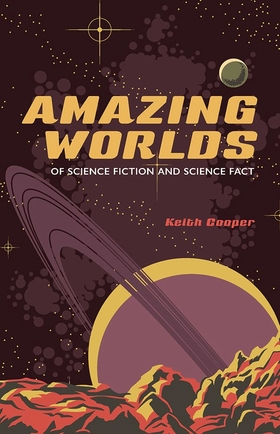Centauri Dreams
Imagining and Planning Interstellar Exploration
What We Can Rule Out at Alpha Centauri
One of the reasons to pay attention to spectrograph technologies — and we recently talked about ESPRESSO, which has just achieved ‘first light’ — is that we’re reaching the inflection point when it comes to certain key observations. Finding planets around Centauri A and B has been the gold standard for a number of researchers, and as Debra Fischer (Yale University) points out, we’re just now getting to where spectrographic technology is up to the challenge.
Chile is where much of the action is. Here we find ESPRESSO installed on the European Southern Observatory’s Very Large Telescope at Paranal. But Fischer’s team has built CHIRON at Cerro Tololo, and the paper likewise relies on data from the Geneva team’s HARPS and the UVES installation at the Very Large Telescope Array in the United States. Working with Yale’s Lily Zhao, Fischer has re-examined older data with an eye toward turning once again to Centauri A and B with a new round of observations beginning the year after next.
The scientist seems quite optimistic, and not just about the technology. In a Yale University news release she says: “Because Alpha Centauri is so close, it is our first stop outside our solar system. There’s almost certain to be small, rocky planets around Alpha Centauri A and B.”
Let’s dig into that assertion a bit. We’ve proceeded at Centauri A and B just as we did at Proxima Centauri, beginning with observations that allowed us to drill down progressively into the possible planet populations there. For a long time, it has been possible to say that no super-Earths larger than 8.5 Earth masses could be detected around Proxima in orbits with a period of 100 days (this was from work by Michael Endl and Martin Kürster). The same work showed that no super-Earths of 2-3 Earth masses could be found in the Proxima habitable zone.
But by pushing to ever more exacting observations, Guillem Anglada?Escudé and team eventually discovered Proxima Centauri b, and now we are on the hunt for further planets there. In the close binary Centauri A and B system, Debra Fischer’s team can do something similar. Their new paper, looking at possibilities in the respective stars’ habitable zones, finds no evidence for planets at Centauri A larger than about 50 Earth masses. At Centauri B, we find no planets larger than about eight Earth masses. That leaves a lot of room for planets of that interesting small, rocky description that, in size at least, remind us of our own.
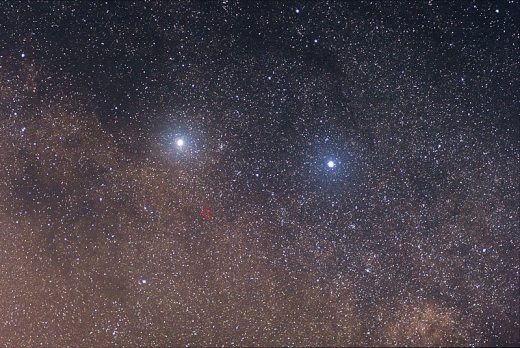
Image: The two bright stars are (left) Alpha Centauri and (right) Beta Centauri. The faint red star in the center of the red circle is Proxima Centauri. Here I always pause to remind people that Beta Centauri is an entirely different star, not part of Alpha Centauri. The stars we know as Centauri A and B are both within the glare of what appears to be the single ‘star’ on the left. The star Beta Centauri is actually in the range of 400 light years from us — don’t confuse it with Centauri B. This image was taken with a Canon 85mm f/1.8 lens with 11 frames stacked, each frame exposed 30 seconds. Credit: Skatebiker at English Wikipedia.
Radial velocity work, looking for the faint back-and-forth motion of a star as it is affected by the gravitational forces of orbiting planets, demands patient and time-consuming analysis. Fischer, Zhao and colleagues used more than a decade of radial velocity measurements for Centauri A and B as well as Proxima, drawing on CHIRON, UVES and HARPS data and using simulated signals to assess the probability that the signal could have been produced by stellar noise alone. The paper shows the lengths to which they went to screen for systematic errors as well.
This gets intriguing, for we know that with radial velocity, a key issue is that we cannot obtain a true planetary mass, but rather a range of masses with a minimum established — this is the result of the fact that in most cases, we cannot know the inclination of the planetary system, so what might appear to be a relatively small planet at minimum could also be much larger.
At Alpha Centauri, though, other factors come into play. Here, the dynamical influences of the binary system mean, according to Zhao and Fischer, that any stable planets are most likely co-planar, or nearly so, with the 79 degree inclination of the stellar binary system. In that case we can derive from radial velocity data a figure that is approximately the actual planet mass for any planets we do find around Centauri A and B. The work demonstrates that terrestrial class worlds could still exist around Centauri A or B and would not have been detected by the past ten years of precision radial velocity searches. The idea that we could find Earth-sized planets using radial velocity methods is still robust, and that includes for searches inside the habitable zone.
Here are the specifics of the result:
At each point in the parameter space of M sin i and orbital period, we sample a Keplerian signal at the actual time of the observations with added white noise scaled to the errors to provide a baseline of planet detection space. These simulations exclude planets within the conservative habitable zone of each planet with a M sin i of greater than 53 M? for ? Cen A, 8.4 M? for ? Cen B, and 0.47 M? for Proxima Centauri on average. This result for ? Cen B comes from the HARPS data set; the CHIRON data set excludes planets in the habitable zone of ? Cen B to greater than 23.5 M?.
Note that finding on Proxima Centauri, which tells us that there could be planets orbiting there that are less than one-half of Earth’s mass. We have a great deal to learn about planet possibilities around all three stars. Note, too, how this work picks up another theme we’ve looked at recently, the use of existing datasets to draw new conclusions. As to future work, the paper gives us the roadmap: We will need radial velocity precision in the 10 centimeters per second space before we can detect the smaller planets that may lurk around Centauri A and B.
ESPRESSO, anyone?
Bear in mind that work on Centauri A and B is currently tricky thanks to the small separation of the two stars as seen from Earth. That angular separation is now increasing, and the authors believe that the two stars will be ‘ideal targets’ for renewed radial velocity study by 2019. Adds Fischer: “The precision of our instruments hasn’t been good enough, until now.”
The paper is Zhao et al., “Planet Detectability in the Alpha Centauri System,” The Astronomical Journal Vol. 155, No. 1 (18 December 2017). Abstract / preprint.

GJ 436b: Polar Orbit May Flag Unseen Companion
Any thought that our Solar System offers a template for other stellar systems has pretty much vanished in the panoply of system architectures now exposed to our observation. But it seemed rational, in the days before we knew of the existence of other systems, to imagine that if they were there, they would be more or less well ordered. Planets presumably orbited in the equatorial plane of their star, all more or less co-planar (and if Pluto didn’t quite fit the bill, that was just more evidence of the features that would one day cause it to become a ‘dwarf planet’).
But looking at the eight planets that remained after Pluto’s ‘demotion,’ we see planets that are co-planar within about 7 degrees of difference. And as Ethan Siegel (Lewis & Clark College) points out, if we take Mercury out of the mix, the deviation from the plane is only about two degrees (Mercury’s inclination is 7 degrees). Likewise, planets in our system line up well with the Sun’s rotation axis. But some systems deviate far from this expected scenario.
This morning in Nature we learn more about the GJ 436 system, a red dwarf already in the public eye because GJ 436b, a transiting ‘hot Neptune,’ has an atmosphere that is evaporating, producing a cloud around the planet itself and a long tail — indeed, GJ 436 has been nicknamed ‘the hairy planet,’ one that evaporates like a comet.
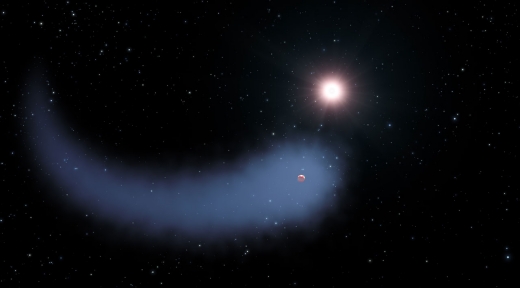
Image: This artist’s concept shows the enormous comet-like cloud of hydrogen bleeding off of the Neptune-sized planet GJ 436b just 30 light-years from Earth. Also depicted is the parent star, which is a faint red dwarf named GJ 436. The hydrogen is evaporating from the planet due to extreme radiation from the star. A phenomenon this large has never before been seen around any exoplanet. Credit: NASA, ESA, and G. Bacon (STScI).
This is a transiting world, so we have been able to determine both mass and radius — the planet is a bit more massive than Neptune, and about 5,000 kilometers larger in diameter. It orbits its host at some 4 million kilometers, fully 15 times closer than Mercury.
Now we learn that researchers at the University of Geneva (UNIGE) have determined that GJ 436b is in a polar orbit. In other words, rather than following in the equatorial plane, it passes above the poles of its star. Moreover, the orbit is eccentric to a degree that, given its proximity to the primary, is likewise unusual. UNIGE’s Vincent Bourrier is first author of the study:
“This planet is under enormous tidal forces because it is incredibly close to its star, barely 3% of the Earth-Sun distance. The star is a red dwarf whose lifespan is very long; the tidal forces it induces should have since circularized the orbit of the planet, but this is not the case!”
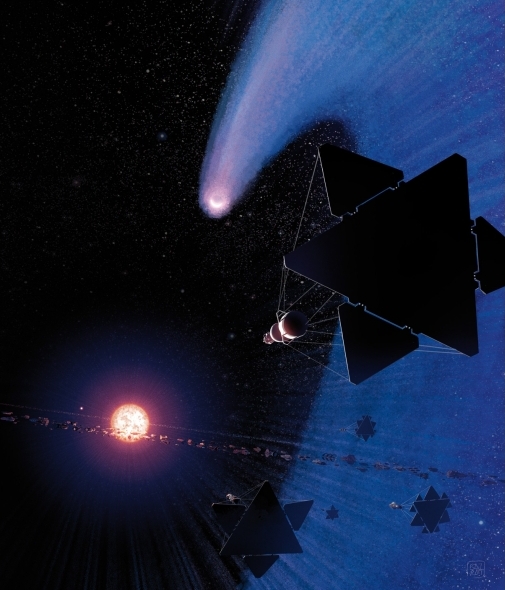
Image: A science fictional look at the GJ 436 system showing a stellar regatta. Space boaters parked in the equatorial plane of the star wait for the ‘hairy’ planet to emerge from this plane to “ride” the planetary wind with the help of kite-surfing vessels. As they rise above the poles of the star, they obtain a breathtaking view of the entire planetary system and can glimpse the mysterious disruptive planet, which appears as a bright spot in the background. Credit: Denis Bajram/UNIGE.
We’re reminded that the architecture of planetary systems preserves the history of their formation, if we can put together the clues. In this case, explaining an orbital scenario can itself become a tool for exoplanet discovery. For the new work ties in with earlier studies of a possible second planet, GJ 436c, around this star. The discovery was announced in 2008 but subsequently retracted, although the possibility of a second world here remained open.
The unusual orbit of GJ 436b now renders the presence of a more massive and distant second planet more likely. Planetary migration may be the cause of GJ 436b’s tight orbit. “Our next goal,” says Bourrier, “is to identify the mysterious planet that has upset this planetary system.”
Full citation when I have it. See also Bourrier et al., “An evaporating planet in the wind: Stellar wind interactions with the radiatively braked exosphere of GJ 436 b,” Astronomy & Astrophysics Vol. 591 (2016), A121 (full text).

Machine Learning: Potent Tool Discovers Two New Worlds
NASA’s news conference announcing the discovery of Kepler-90i and Kepler-80g was a delightful validation of a principle that has long fascinated me. We have such vast storehouses of astronomical data that finding the time for humans to mine them is deeply problematic. The application of machine learning via neural networks, as performed on Kepler data, shows what can be accomplished in digging out faint signals and hitherto undiscovered phenomena.
Specifically, we had known that Kepler-90 was a multi-planet system already, the existing tools — human analysis coupled with automated selection methods — having determined that there were seven planets there. Kepler-90i emerged as a very weak signal, and one that would not have made the initial cut using existing methods of analysis. When subjected to the machine learning algorithms developed by Google’s Christopher Shallue and Andrew Vanderburg (UT-Austin), the light curve of Kepler-90i as well as that of Kepler-80g could be identified.
Christopher Shallue described the work at the news conference:
“Kepler produced so much data that scientists couldn’t examine it all manually. The method has been to look at the strongest signals, examining them with human eyes and automated tests, not so different from looking for needles in a haystack. Out of 30,000 signals examined, 2500 planets could be confirmed. We chose to search in weaker signals, as if in a much bigger haystack.”
Machine learning shines in such situations, with the neural network able to identify planets with a far weaker signal that would have never made the initial cut for human analysis. In order to train the network, Shallue and Vanderburg fed it 15,000 Kepler signals that had already been labelled by human scientists, allowing it to learn by example to distinguish those patterns caused by planets. In their test runs, the model identified planets 96 percent of the time.
Shallue described the machine learning system as a neural network made up of layers that perform individual computations and pass them along to the next layer in the stack. Given enough layers, it becomes possible to recognize complex patterns, as we have seen in language translation, image and object identification, and the detection of tumors. Now we turn these methods to exoplanet detection in a discovery that bodes well for future discovery.
The two new planets were found through analysis of Kepler data on 670 stars, a major proof of concept for a method that will doubtless continue to improve, and one that will eventually be applied to the entire range of 150,000 stars in the Kepler and K2 dataset. That opens the possibility of numerous new planetary discoveries from the Kepler mission alone, not to mention what we will find with more advanced AI using the TESS and JWST datasets.
Andrew Vanderburg provides a bit more detail on the method at his CfA page:
Once we had built a neural network, we decided to test it out on some new signals. Using traditional transit-search methods (in particular, the same methods I use to search K2 data), we performed a new search of a handful of systems observed by Kepler (in particular, about 670 systems known already to host multiple planets). Importantly, we allowed this search to very sensitively explore weak signals. Usually, when searching Kepler data, a threshold in signal strength is set, below which weak signals are discarded, so as not to overwhelm the searcher with false positive signals. By lowering this threshold in our new search, we suspected that we might find some new planets, at the expense of a large increase in the number of false positives. But because we have a neural network that can efficiently identify real planets and screen out false positives, we could still efficiently identify new planets.
As to the planets themselves, Kepler-90i, orbiting a G-class star somewhat larger and more massive than the Sun some 2500 light years away, is interesting because it turns the Kepler-90 system into the closest thing we have to a Solar System analog, at least in terms of the number of planets. But the resemblance is hardly complete, for these planets exist in a highly compact system. Have a look at the orbital configuration here.
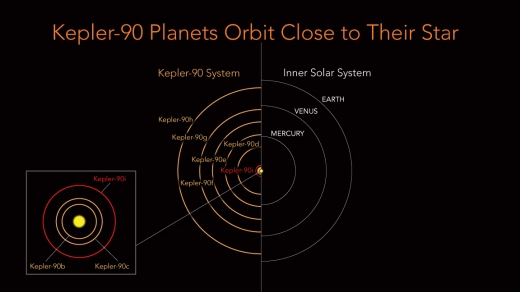
Image: Kepler-90 is a Sun-like star, but all of its eight planets are scrunched into the equivalent distance of Earth to the Sun. The inner planets have extremely tight orbits with a “year” on Kepler-90i lasting only 14.4 days. In comparison, Mercury’s orbit is 88 days. Consequently, Kepler-90i has an average surface temperature of 800 degrees F. Credit: NASA.
The image below shows an artist’s concept of the planets in question, though the distances are obviously not to scale. The planet sizes, however, are.
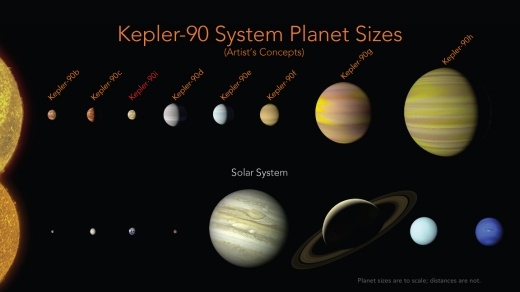
Image: The Kepler-90 planets have a similar configuration to our solar system with small planets found orbiting close to their star, and the larger planets found farther away. Credit: NASA.
Kepler-80g has an orbital period close to that of Kepler-90i, about 14 days, and is the 6th planet in its system, which has a host star that is either a late K-dwarf or an early M-dwarf. Here we find the already discovered five planets orbiting in a resonance chain, with mutual gravitational interactions keep their orbits aligned. As Andrew Vanderburg pointed out, the orbital period of the new planet could have been predicted based on the mathematical relations of this resonance, within about two minutes of the actual measure.
It was heartening to hear at the news conference that the training model used in these detections will be made publicly available. According to Google’s Shallue, about two hours suffice to train the model on a desktop computer using open source machine learning software called TensorFlow, which is produced by Google. When the code becomes available, anyone will be able to use the model on the publicly available Kepler data on their own PCs.
The paper is Shallue & Vanderburg, “Identifying Exoplanets with Deep Learning: A Five Planet Resonant Chain around Kepler-80 and an Eighth Planet around Kepler-90,” accepted for publication in The Astronomical Journal, and for now available here.

Modeling an Exoplanetary ‘Mars’
Until we can start observing the atmospheres of rocky worlds around red dwarf stars, we’re left to extrapolate conditions there as best we can. New work discussed at the fall meeting of the American Geophysical Union on Dec. 13 recounts one such attempt, using the planet Mars as a surrogate for a similar world in habitable zone orbit around an M-dwarf. The work draws on data from the MAVEN (Mars Atmosphere and Volatile Evolution) mission, launched in 2013 and now orbiting the Red Planet. Designed to study the deterioration of its atmosphere over time, MAVEN offers insights into exoplanets that are derived from plugging in different stellar values.

Image: To receive the same amount of starlight as Mars receives from our Sun, a planet orbiting an M-type red dwarf would have to be positioned much closer to its star than Mercury is to the Sun. Credit: NASA/GSFC.
MAVEN co-investigator David Brain (University of Colorado, Boulder) discussed MAVEN data at the meeting, noting that the planet has lost the bulk of its atmosphere to space through a combination of physical and chemical factors. Aiding the study have been periods of higher and lower solar activity, which have subjected Mars to solar storms, solar flares and coronal mass ejections (CMEs). The processes of atmospheric escape in play led to Brain and team’s calculations on a similar planet positioned at the edge of the habitable zone of a red dwarf.
The results: The tight orbit a planet would need to occupy to be in the habitable zone of a red dwarf would place it much closer to its star than Mercury is to the Sun. Extreme ultraviolet from the host would subject the planet to 5 to 10 times more UV radiation than Mars currently receives. According to the calculations, such a world would lose 3 to 5 times as many charged particles as Mars does in our system, through a process known as ion escape.
But ion escape is only one way to degrade a planetary atmosphere. Photochemical escape refers to the loss of neutral particles when ultraviolet radiation breaks down molecules in the upper atmosphere. The researchers found that this process is 5 to 10 times more effective in the red dwarf scenario, leading to the creation of charged particles that cause ‘sputtering’, where energetic particles are accelerated and create molecular collisions.
Some of the affected molecules, in turn, escape into space, furthering the atmospheric loss. A final process — thermal escape, or Jeans escape — happens to lighter molecules and particularly affects hydrogen, which is lost at the top of the atmosphere. Brain’s team believes that thermal escape would be enhanced if the high UV levels the red dwarf planet would experience push more hydrogen to the top of the atmosphere.
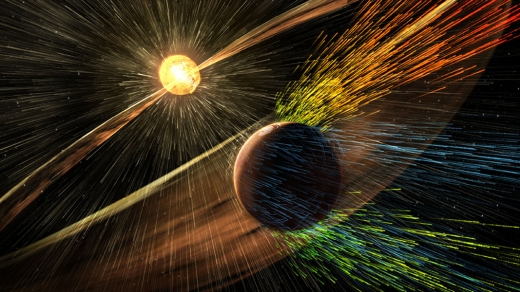
Image: This illustration depicts charged particles from a solar storm stripping away charged particles of Mars’ atmosphere, one of the processes of Martian atmosphere loss studied by NASA’s MAVEN mission, beginning in 2014. Unlike Earth, Mars lacks a global magnetic field that could deflect charged particles emanating from the Sun. Credit: NASA/GSFC.
We wind up with a depressing scenario for habitability, with even a quiet M-class dwarf shortening the habitable period of the planet by a factor as high as 20. A more active M-dwarf, according to this JPL news release, would shorten habitability by a factor of 1,000. The period during which life could arise is drastically shortened and still at the mercy of stellar storms.
But while the researchers see serious habitability issues for a Mars-class planet in this scenario, they point out that a planet with active geology could find its atmosphere replenished, while one with a magnetic field could be shielded to some extent from the effects of the stellar wind. A world of larger size than Mars would also have a larger gravitational field, allowing it to hold on to more of its atmosphere. Mars-like planets, then, are not candidates for habitable conditions even in a red dwarf habitable zone, but different kinds of planets may fare better.

MU69: New Horizons and its Target
We’re just a little more than a year away from New Horizons’ encounter with Kuiper Belt Object MU69. The spacecraft has now made its last trajectory correction of the cruise phase of its journey, following the 2015 flyby of Pluto/Charon, an adjustment performed to optimize science at destination. Both the Hubble instrument and the European Space Agency’s Gaia mission have supplied data that is now being used to tighten the parameters of the trajectory. Another course correction is possible in October of 2018 during the MU69 approach phase.
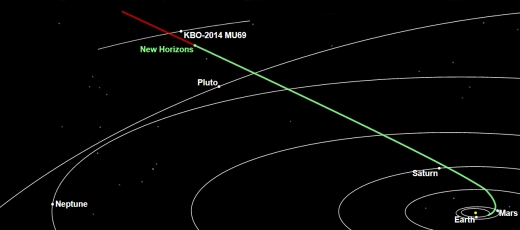
Image: The New Horizons spacecraft is about 483 million kilometers from 2014 MU69, the Kuiper Belt object it will encounter on Jan. 1, 2019. Credit: NASA/Johns Hopkins University Applied Physics Laboratory/Southwest Research Institute.
This update from JHU/APL tells us that closest approach is now scheduled for 0533 UTC, or 0033 EST on January 1, 2019, which should give many New Year’s partygoers something extra to stay up for. The course adjustment was performed to optimize visibility for the antennae of the Deep Space Network, which will reflect radar waves off the surface of MU69 in an experiment that, if successful, will help determine the reflectivity of its surface.
The 2.5-minute engine burn on December 9 thus sets a record for the farthest spacecraft course correction ever performed, at a distance of 6.1 billion kilometers. At this distance, radio confirmation took 5 hours and 41 minutes. The course was adjusted by approximately 151 centimeters per second, setting up a planned flyby distance of 3500 kilometers. New Horizons goes back into hibernation mode on December 21 and will remain in that mode until June.
Learning About the Target
Meanwhile, the occultation events of last June and July, which saw teams setting up telescopes in the shadow of the KBO as it passed in front of a star, have proved invaluable at assessing the shape of MU69, particularly the July 17 occultation, which produced information on the object’s size, shape and orbital characteristics. But it was data gathered by the Stratospheric Observatory for Infrared Astronomy (SOFIA) on July 10 that may be the most provocative, showing an abnormality in the occultation that could indicate a small moon.
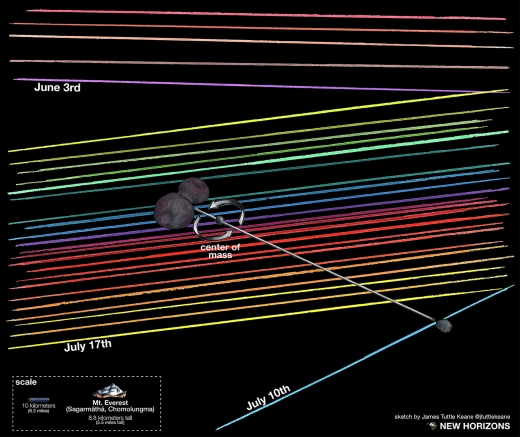
Image: On three occasions in June and July 2017, New Horizons mission team members attempted to track a small, distant Kuiper Belt object, 2014 MU69, as it passed in front of a star – an event known as an occultation. The colored lines mark the path of the star as seen from different telescopes on each day; the blank spaces on those lines indicate the few seconds when MU69 blocked the light from the star. Scientists are using these observations to craft a picture of MU69 and any companion bodies. (Credit: NASA/Johns Hopkins University Applied Physics Laboratory/Southwest Research Institute/James Tuttle Keane).
Marc Buie (SwRI), a member of the New Horizons science team, updated the analysis of the MU69 occultations at the American Geophysical Union fall meeting in New Orleans.
“We really won’t know what MU69 looks like until we fly past it, or even gain a full understanding of it until after the encounter,” said Buie. “But even from afar, the more we examine it, the more interesting and amazing this little world becomes… A binary with a smaller moon might also help explain the shifts we see in the position of MU69 during these various occultations. It’s all very suggestive, but another step in our work to get a clear picture of MU69 before New Horizons flies by, just over a year from now.”
What we do know at this point is that MU69 is more than 6.5 billion kilometers from Earth and no more than 30 kilometers long if a single object, or if it is a binary, then each component is roughly 15-20 kilometers in diameter. Scientists are hopeful that the flyby will give us information about the earliest era of planet formation in the outer Solar System. In any case, the more we learn about it, the more intriguing this clearly worthwhile target becomes.
“The occultation effort that Marc Buie and his team led for New Horizons has been invaluable in opening our eyes to the very real possibilities that MU69 is both a lot more complex than anyone suspected, and that it holds many surprises for us at flyby on New Year’s Eve and New Year’s Day, 2019,” added New Horizons principal investigator Alan Stern, also from Southwest Research Institute. “The allure of its exploration is becoming stronger and stronger as we learn more and more about it. It’s just fantastic!”
As the mission continues, you can keep up with New Horizons’ position here.

Keeping Up with Juno
We’re getting interesting results from analysis of Juno’s close flybys of Jupiter. The spacecraft has detected hydrogen, oxygen and sulfur ions moving at relativistic speeds in a new radiation zone just outside the atmosphere. We have its JEDI (Jupiter Energetic Particle Detector Instrument) to thank for the detection, which was made during approaches as close as 3400 kilometers from the cloud tops. Fast moving atoms without an electric charge — energetic neutral atoms — are thought to be the source of the new radiation zone as they move from gas around Io and Europa and become ionized in Jupiter’s upper atmosphere.
The new radiation zone is inside Jupiter’s previously known radiation belts, which have also been under scrutiny by Juno. High-energy, heavy ions have been detected in the inner edges of the planet’s electron radiation belt, previously thought to be made up primarily of electrons moving at near light speed. The heavy ions show up at high latitude locations within the electron belt, detected by Juno’s Stellar Reference Unit (SRU-1) star camera. You can see the locations where they were detected in the bright spots along the white line of Juno’s flight path below.
“The closer you get to Jupiter, the weirder it gets,” said Heidi Becker, Juno’s radiation monitoring investigation lead at JPL. “We knew the radiation would probably surprise us, but we didn’t think we’d find a new radiation zone that close to the planet. We only found it because Juno’s unique orbit around Jupiter allows it to get really close to the cloud tops during science collection flybys, and we literally flew through it.”
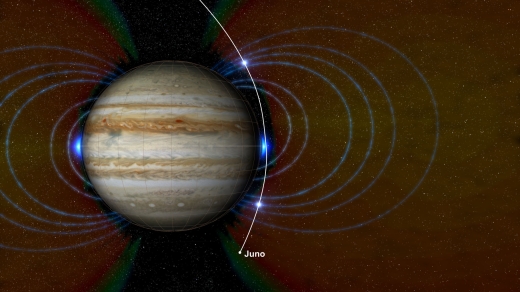
Image: This graphic shows a new radiation zone surrounding Jupiter, located just above the atmosphere near the equator, that has been discovered by NASA’s Juno mission. The new radiation zone is depicted here as a glowing blue area around the planet’s middle. Credit: NASA/JPL-Caltech/SwRI/JHUAPL.
Meanwhile, Juno’s microwave radiometer (MWR) instrument also culled data during Juno’s passage over the Great Red Spot in July of 2017. The figure below represents six channels of these data. Using the MWR, Juno can see deeper than any previous ground- or space-based observations into the clouds. It’s interesting to note that the large-scale structure of the Great Red Spot is evident as deep into the planet as the MWR can observe. 16,000 kilometers wide, the Great Red Spot is a vast crimson storm that has been monitored since 1830. It was twice Earth’s diameter when the Voyagers studied it but has since diminished in width.
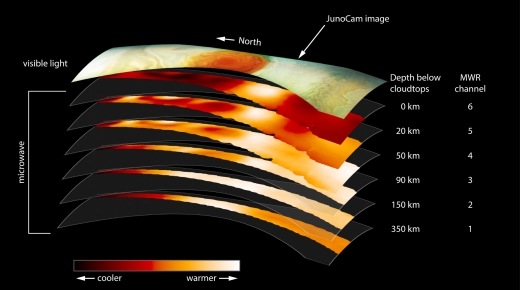
Image: This figure shows data from the six channels of the microwave radiometer (MWR) instrument onboard NASA’s Juno spacecraft. The data were collected in the mission’s sixth science orbit (referred to as “perijove 7”), during which the spacecraft passed over Jupiter’s Great Red Spot. The top layer in the figure is a visible light image from the mission’s JunoCam instrument, provided for context. Credit: NASA/JPL-Caltech/SwRI.
“Juno found that the Great Red Spot’s roots go 50 to 100 times deeper than Earth’s oceans and are warmer at the base than they are at the top,” said Andy Ingersoll, professor of planetary science at Caltech and a Juno co-investigator. “Winds are associated with differences in temperature, and the warmth of the spot’s base explains the ferocious winds we see at the top of the atmosphere.”
But below is the image that awakens the science fiction fan in me. It’s an animation assembled from JunoCam imagery to give us a sense of the winds in the Great Red Spot, using a velocity field model derived from earlier observations including those from Voyager. The animation is the work of two citizen scientists, Gerald Eichstädt and Justin Cowart, with Juno scientists Shawn Ewald and Andrew Ingersoll applying the velocity data to produce the finished animation.
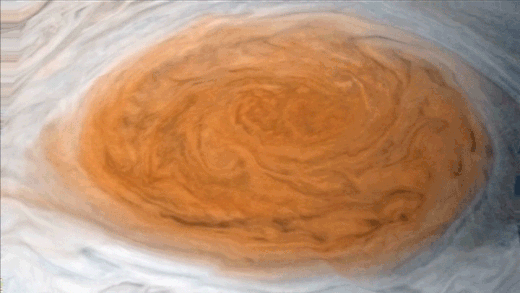
Image: Winds around Jupiter’s Great Red Spot are simulated in this JunoCam view that has been animated using a model of the winds there. The wind model, called a velocity field, was derived from data collected by NASA’s Voyager spacecraft and Earth-based telescopes. NASA’s Juno spacecraft acquired the original, static view during passage over the spot on July 10, 2017. Credit: NASA/JPL-Caltech/SwRI/MSSS/Gerald Eichstadt/Justin Cowart.
If you’d like to dig into the analysis of radiation data, the paper is Kollman et al., “A heavy ion and proton radiation belt inside of Jupiter’s rings,” Geophys. Res. Lett 44, 5259-5268 (abstract).

